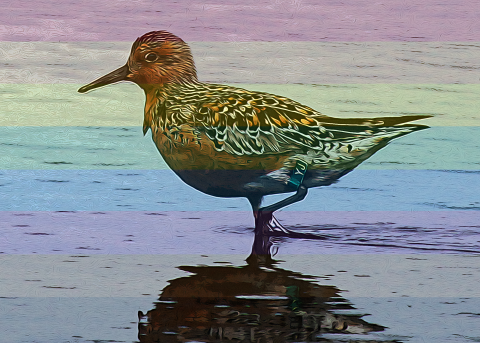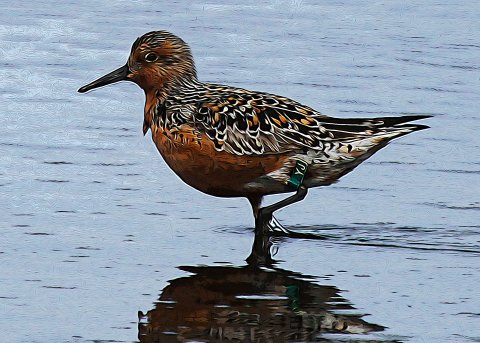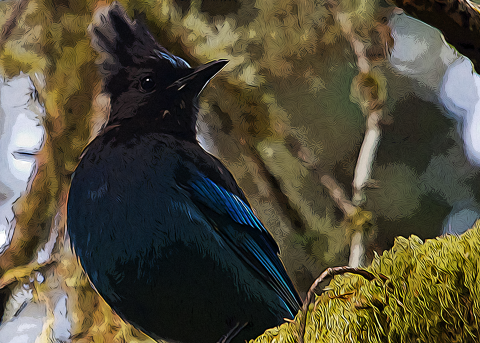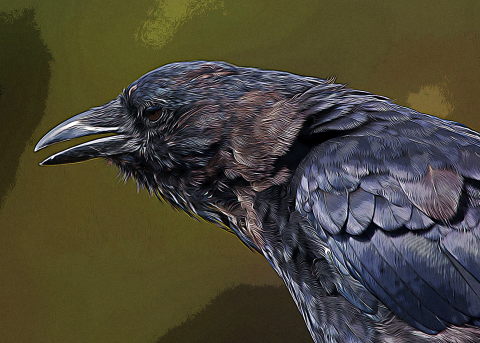It's Pride Month, and our favorite birds have their eyes on rainbows! Cities all over the United States are hosting parades, concerts, and other kaleidoscopically amped events to celebrate. The best part? We have an early lead on birds getting ready to march through the Pacific Northwest.
Below is the ultimate list of avian Pride partygoers, including who they’re walking with and the jams they’re listening to, their flying freebies and even flyer accessories. Read on so you know before you go!
Anna's Hummingbirds
Who’s Who: Count on Anna’s hummingbirds to bring the buzz! Mostly green and gray, these tiny birds are known for their brilliant pink or red feathers on their necks. When they’re not marching in parades, you can find them in both urban and natural areas. Don’t blink—hummingbirds move (and dance) so fast, they might look a little blurry!
Walking With: The Year-Round Birds Unite Club. Unlike most hummingbirds, Anna’s hummingbirds can be found year-round in the Pacific Northwest.
Pride Jam: Anna’s hummingbirds bring the beats—they'll buzz, chirp AND whistle. Click on this link to listen to the call of Anna’s hummingbird on xeno-canto.
Giveaways: Watch out for flying candy! These hummingbirds love to eat nectar, sugar water and sap. We bet they’ll bring something sugary to eat, and more than enough to share.
Accessories: Anna’s hummingbird doesn’t need anything glittery—their bright pink or red neck feathers bring enough dazzle. But standing only 3.9 inches tall, these little birds might decide to walk in their tallest (and most comfortable) heels.
Rosealarii Red Knots
Who’s Who: Don’t let their names fool you. These orange-bellied little shorebirds have small heads and eyes and a tapering black bill that is perfect for eating mollusks.
Walking With: The Ultra-Migrators Society. Red knots make one of the longest distance migrations in the animal kingdom. They can travel up to 19,000 miles each year, chasing warm weather in the southern hemisphere in the winter and breeding grounds in North America in the summer.
Pride Jam: Rosealarii red knots will be the pied pipers of the Pride Parade. Singing males make a flute-like poorr-me sound, but these birds can also yodel and chatter when they’re excited to scared. Click on this link to listen to the call of red knots on xeno-canto.
Giveaways: Head over to the Ultra-Migrators tent after the parade for bowls of chilled mollusk chowder.
Accessories: These shorebirds are going to be well prepared for the sun—we bet they’ll have some brightly colored, reflective sunglasses!
Western Tanagers
Who’s Who: Red and orange with yellow bodies, these songbirds are on fire! They like living in the woods but may make an appearance in your yard if you put out fresh or dried fruit.
Walking With: The Dancing Kings. Male western tanagers like to flash their tumbling moves during mating dances.
Pride Jam: Keep it short and sweet for western tanagers—these chirpy birds with robin-like calls have a packed Pride schedule. Click on this link to listen to the call of western tanagers on xeno-canto.
Giveaways: Our tanagers are going all Oprah-style generous and handing out binoculars. You’re going to need them to see their nests, usually located in trees 15-65' above the ground!
Accessories: When they’re not walking around showing off their fire-colored feathers, we bet these trend-setters wear tees with delicious insect and berry prints.
Pacific-Slope Flycatchers
Who’s Who: The teenie-greenie Pacific-slope flycatcher have made the long trek down from coastal and Cascade forests and mountains to march in this year’s Pride, and we couldn’t be happier to see them. Small and greenish-brown in color, these birds are about the size of chickadees and hard to spot in the forest canopies where they live and breed. They winter in Mexico and summer in the Pacific Northwest—we're guessing just to wave rainbow flags with us.
Walking With: Flycatchers Incognito. The Pacific-slope flycatcher’s species name is Empidonax difficilis, an apt name for a species that’s difficult to distinguish from other flycatchers.
Pride Jam: All soprano, all the time. These singers like to belt out some high-pitched peets and pee-weets! Click on this link to listen to the call of the Pacific-slope flycatcher on xeno-canto.
Giveaways: We heard a rumor that our greenies are going to toss out some plastic insects—beetles, bees, and flies. If you can’t eat ‘em, join ‘em!
Accessories: Who needs print tees? These flycatchers are bringing spiderweb: useful for nest-building, but we’ve always wanted sticky lassos on a Pride dance floor.
Steller’s Jays
Who’s Who: No need for hairspray—the Pacific Northwest’s Steller’s jay already rocks a fabulous mohawk. Nearly the size of a small crow, Steller’s jays have brilliant blue body and black head feathers, with black crowns that arch up over long straight beaks.
Walking With: Pacific Northwest Camping Club. These inquisitive little birds love hanging out in mountains and campsites, especially to sniff out human food.
Pride Jam: Whatever will get you to shake, shake, shake! Steller’s jays make a repetitive shook-shook-shook call, and can also whistle, gurgle, and pop during other interactions. Click on this link to listen to the call of the Steller's jay on xeno-canto.
Giveaways: Hair gel packets. Imitation is the best form of...fluttery?
Accessories: Peanuts, suet, nuts—whatever they can carry to help get them through a long march (and subsequent winter).
Rock Pigeons
Who’s Who: Look out—it's the out-of-towners! A seasoned Pride-goer, rock pigeons (also known as rock doves) love themselves some multicolored festivals. Although they vary in color, our pigeons can be distinguished by their short, stubby bodies, gray or black bodies, and iridescent purple feathers on their necks. Rock pigeons originated in Europe, Africa, and Asia, but they now attend Prides around the world.
Walking With: Everyone. Even if they weren’t invited.
Pride Jam: Soft rock and R&B. Rock pigeons will try to coooo their way into your heart. Click on this link to listen to the call of rock pigeons on xeno-canto.
Giveaways: Tuppence. Thanks, Mary Poppins.
Accessories: Secret messages. Did you know that trained rock pigeons were used to transmit information by the U.S. Army during World Wars I and II? Who needs a cell phone?
Golden Eagles
Who’s Who: A hush falls over the crowd. You turn your head to see pairs of golden eagles swooping down the road, brown wings out, eyes alert. These big, powerful birds are making a special trip into the city from their preferred habitat of wide-open country. With a seven-foot-wide wingspan, you can feel their feathers brush your face as they fly past.
Walking With: The We’re Not Those Other Eagles Club. While bald eagles may be the most famous raptor in the country, golden eagles are just as majestic. They can live up to 30 years in the wild, which gives them lots of time to find their life-long mates.
Pride Jam: We bet these raptors like some hard rap beats—and whatever else gets them pumped for dive-bombing prey. Click on this link to listen to the call of golden eagles on xeno-canto.
Giveaways: Pamphlets on the Bald and Golden Eagle Protection Act. A little dry, but they’re assuming you’ll look later.
Accessories: Nothing. When you’re a golden eagle, you don’t need accessories.
American Crows
Who’s Who: No need to crow about it—the American Crow knows you know (and you know they know, just to get meta). These large, black, intelligent birds are famous for their smarts, loud cawing cry, and omnipresence. They’ll show up to Pride in all black, but their personalities are colorful enough to make up for it.
Walking With: The Murder She Wrote Fan Club. These crows are going to crack the case before Pride’s over (or in 57 minutes, including commercials).
Pride Jam: Anything cawwwntry. Click on this link to listen to the call of the American crow on xeno-canto.
Giveaways: A pocket-sized book of Aesop’s Fables. Then if you’re stuck with a pitcher of water with a long, high neck, and a surplus of pebbles - you’ll know exactly what to do.
Accessories: Monocles. Because who doesn’t like monocles?












